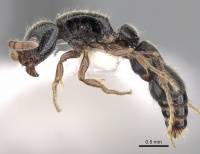Lioponera hewitti
| Lioponera hewitti | |
|---|---|

| |
| Scientific classification | |
| Kingdom: | Animalia |
| Phylum: | Arthropoda |
| Class: | Insecta |
| Order: | Hymenoptera |
| Family: | Formicidae |
| Subfamily: | Dorylinae |
| Genus: | Lioponera |
| Species: | L. hewitti |
| Binomial name | |
| Lioponera hewitti (Wheeler, W.M., 1919) | |
Identification
Distribution
Latitudinal Distribution Pattern
Latitudinal Range: 4.966666667° to 1.55°.
| North Temperate |
North Subtropical |
Tropical | South Subtropical |
South Temperate |
- Source: AntMaps
Distribution based on Regional Taxon Lists
Indo-Australian Region: Borneo (type locality), Indonesia, Malaysia, Singapore.
Distribution based on AntMaps
Distribution based on AntWeb specimens
Check data from AntWeb
Countries Occupied
| Number of countries occupied by this species based on AntWiki Regional Taxon Lists. In general, fewer countries occupied indicates a narrower range, while more countries indicates a more widespread species. |

|
Estimated Abundance
| Relative abundance based on number of AntMaps records per species (this species within the purple bar). Fewer records (to the left) indicates a less abundant/encountered species while more records (to the right) indicates more abundant/encountered species. |

|
Biology
Castes
Nomenclature
The following information is derived from Barry Bolton's Online Catalogue of the Ants of the World.
- hewitti. Phyracaces hewitti Wheeler, W.M. 1919e: 48 (w.q.) BORNEO (East Malaysia: Sarawak).
- Type-material: 4 syntype workers, 3 syntype queens.
- Type-locality: Malaysia (Borneo): Sarawak, Kuching (J. Hewitt).
- Type-depositories: BMNH, MCZC.
- Combination in Cerapachys: Brown, 1975: 22;
- combination in Lioponera: Borowiec, M.L. 2016: 164.
- Status as species: Chapman & Capco, 1951: 22; Brown, 1975: 22, 68; Bolton, 1995b: 143; Pfeiffer, et al. 2011: 33.
- Distribution: Malaysia (Sarawak).
Description
References
- Borowiec, M.L. 2016. Generic revision of the ant subfamily Dorylinae (Hymenoptera, Formicidae). ZooKeys 608: 1-280 (doi:10.3897/zookeys.608.9427).
- Arnold, G. 1926. A monograph of the Formicidae of South Africa. Appendix. Ann. S. Afr. Mus. 23: 191-295 (page 192, worker described [Unresolved junior secondary homonym of hewitti Wheeler])
- Bolton, B. 1995b. A new general catalogue of the ants of the world. Cambridge, Mass.: Harvard University Press, 504 pp. (page 143, catalogue)
- Bolton, B. 1995b. A new general catalogue of the ants of the world. Cambridge, Mass.: Harvard University Press, 504 pp. (page 143, catalogue)
- Brown, W. L., Jr. 1975. Contributions toward a reclassification of the Formicidae. V. Ponerinae, tribes Platythyreini, Cerapachyini, Cylindromyrmecini, Acanthostichini, and Aenictogitini. Search Agric. (Ithaca N. Y.) 5(1 1: 1-115 (page 22, Combination in Cerapachys)
- Brown, W. L., Jr. 1975. Contributions toward a reclassification of the Formicidae. V. Ponerinae, tribes Platythyreini, Cerapachyini, Cylindromyrmecini, Acanthostichini, and Aenictogitini. Search Agric. (Ithaca N. Y.) 5(1 1: 1-115 (page 22, junior synonym of arnoldi)
- Chapman, J. W.; Capco, S. R. 1951. Check list of the ants (Hymenoptera: Formicidae) of Asia. Monogr. Inst. Sci. Technol. Manila 1: 1-327 (page 22, checklist)
- Donisthorpe, H. 1931d. Descriptions of some new species of ants. Ann. Mag. Nat. Hist. 10(8): 494-501 (worker, male described)
- Wang, W.Y., Soh, E.J.Y., Yong, G.W.J., Wong, M.K.L., Benoit Guénard, Economo, E.P., Yamane, S. 2022. Remarkable diversity in a little red dot: a comprehensive checklist of known ant species in Singapore (Hymenoptera: Formicidae) with notes on ecology and taxonomy. Asian Myrmecology 15: e015006 (doi:10.20362/am.015006).
- Wheeler, W. M. 1919f. The ants of Borneo. Bulletin of the Museum of Comparative Zoology 63: 43-147 (page 48, worker, queen described)
- Yamane, S., Tanaka, H.O., Hasimoto, Y., Ohashi, M., Meleng, P., Itioka, T. 2021. A list of ants from Lambir Hills National Park and its vicinity, with their biological information: Part II. Subfamilies Leptanillinae, Proceratiinae, Amblyoponinae, Ponerinae, Dorylinae, Dolichoderinae, Ectatomminae and Formicinae. Contributions from the Biological Laboratory, Kyoto University 31, 87–157.
References based on Global Ant Biodiversity Informatics
- Chapman, J. W., and Capco, S. R. 1951. Check list of the ants (Hymenoptera: Formicidae) of Asia. Monogr. Inst. Sci. Technol. Manila 1: 1-327
- Donisthorpe H. 1931. Descriptions of some new species of ants. Annals and Magazine of Natural History (10)8: 494-501.
- Pfeiffer M.; Mezger, D.; Hosoishi, S.; Bakhtiar, E. Y.; Kohout, R. J. 2011. The Formicidae of Borneo (Insecta: Hymenoptera): a preliminary species list. Asian Myrmecology 4:9-58
- Wheeler W. M. 1919. The ants of Borneo. Bulletin of the Museum of Comparative Zoology 63:43-147.
- Woodcock P., D. P. Edwards, R. J. Newton, C. Vun Khen, S. H. Bottrell, and K. C. Hamer. 2013. Impacts of Intensive Logging on the Trophic Organisation of Ant Communities in a Biodiversity Hotspot. PLoS ONE 8(4): e60756. doi:10.1371/journal.pone.0060756
- Woodcock P., D. P. Edwards, T. M. Fayle, R. J. Newton, C. Vun Khen, S. H. Bottrell, and K. C. Hamer. 2011. The conservation value of South East Asia's highly degraded forests: evidence from leaf-litter ants. Phil. Trans. R. Soc. B. 366: 3256-3264.
- Woodcock P., D.P. Edwards, T.M. Fayle, R.J. Newton, C. Vun Khen, S.H. Bottrell, and K.C. Hamer. 2011. The conservation value of South East Asia's highly degraded forests: evidence from leaf-litter ants. Phil. Trans. R. Soc. B 366: 3256-3264.

